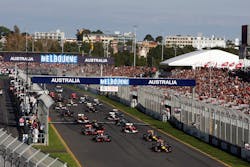The Australian Grand Prix from a tire point of view
Pirelli enters its second season of Formula One as exclusive tire supplier with the entire range of tires renewed compared to the previous year. This has been in response to new aerodynamic and technical regulations, which have had a profound impact on car design.
Blown diffusers are now forbidden, with the exhaust outlets now having to exit the car higher and pushing the center of pressure forwards. Previously the blown diffusers used to give improved grip at the rear of the car, even when the driver was off the throttle. This alters the fundamental balance of the car, and also affects the tires along with the way that they are used. The aerodynamics now work on the car in a different way, redistributing the forces that are acting on the tires and altering the driver’s feeling. Many of the cars also now have a stepped nose.
A greater proportion of force on the front axle means that there is better turn-in and superior driving precision in corners, as well as improved medium-speed to high-speed direction changes.
But with the forces moving more towards the front of the car, a weaker rear end means that the rear tires have to work even harder to avoid sliding through corners, as well as combatting wheelspin under acceleration.
The driving style needed to control the rear during these periods of oversteer and wheelspin puts plenty of stress onto all the tires, which translate into higher working temperatures on both the front and the rear. As a result there is more rear degradation and a balance that moves towards oversteer during a race stint.
Pirelli has reacted by giving the rear tires more grip and adopting ‘squarer’ profiles to present a greater contact patch to the track. The new profiles, designed to distribute stresses more evenly across the entire tire footprint, even in extreme conditions, compensate for the latest technical restrictions. At the same time, they work perfectly with driving styles that are increasingly more complex and aggressive to deal with the reduced grip at the rear.
Another important new tire regulation for 2012 is the fact that drivers can have all 11 sets of their weekend’s allocation available from Friday. This is designed to avoid drivers limiting their running in order to save tires for later, and it should give spectators the chance to see more action.
Finally, Pirelli’s color markings are more prominent this year, and there is a new name for the wet-weather tires: Cinturato. This is the name of the tires with which Pirelli first entered Formula One, back in the 1950s.
THE CHALLENGE FOR THE TIRES IN MELBOURNE:
The life of a tire at Albert Park becomes very different over the course of the weekend as the circuit rubbers in and gets progressively faster. Combined traction is the key element of the 5.303-kilometer semi-permanent circuit, with the race taking in 58 laps. The teams use a comparatively high level of downforce, which is necessary due to the quick succession of corners and absence of long straights. Oversteer on the exit of corners is a particular problem for the rear tires as the sliding can increase wear, while the front-left tire is subjected to a lot of stress throughout the lap as well.
A place where the tires and cars are worked especially hard is turn two. The drivers scrub off 200 kilometers per hour in just 2.5 seconds and 108 meters under braking, subjecting themselves to a 5G deceleration while the front tires are pushed into the ground by 1150 kilograms of downforce.
Turns 11 and 12 are two of the key points of Albert Park. The exit speed from the corner is in the region of 210 kilometers per hour. The stressed front tire (on the outside of the curve) is operating at around 105° centigrade, whereas the inside tire on the right has slightly less work to do and runs five degrees cooler at around 100° centigrade. The rear tires operate at temperatures in excess of 100° centigrade.
Another important area is the braking zone between turns 14 and 16, which loads the front of the car heavily leading into a chicane with tight right-angle corners before the main straight. This is the only place on the track where the cars top 300 kilometers per hour in seventh gear, and it is where the left-rear tire has its temperature peak.
